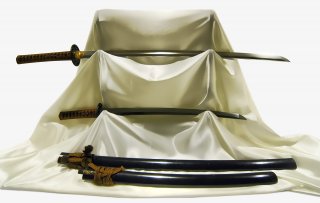
Fujiwara Tadakuni and Fujiwara Masahiro
Japanese Swords
Japanese Steel, wood, lacquer, iron, gold, and silk 39 ½ and 28 inches Museum purchase 1975.46
Heavenly Metal
Through centuries of conflict Japanese craftsmen refined swords into weapons of outstanding strength, resilience, and beauty. Swords were the essential equipment of samurai, members of the military class who followed a strict code of conduct. By the 1400s, swords were often carried as a pair (daisho), a long sword (katana) and a short sword (wakizashi).
A Day in the Life
Tools and Techniques
A Group Effort
Many hands were involved in the production of these swords, some known and some anonymous. These included:
The swordsmiths who forged the blades. Fujiwara Masahiro made the short sword (wakizashi), and Fujiwara Tadakuni made the long sword (katana). Their names are inscribed on the blade handles. Both lived in the first half of the 17th century, and both worked in Hizen province (parts of modern-day Saga and Nagasaki prefectures). Also, both received honorary titles from Imperial officials, titles they were allowed to inscribe on their blades, adding prestige. However, the two artists were not connected and the pairing of these swords came at a later date. The scabbard and other fittings were added at a later date as well.
The sword polisher who revealed the fine and unique qualities of the blade.
The carpenter who made the scabbard and hilt.
The silk artisan who made the cording.
The lacquer artisan who decorated the scabbard.
The metal craftsmen who made the sword guard and other accessories, such as the small menuki on the hilt (see "Look Around").
The most important part was forging, a complex and labor-intensive process that refined steel into a blade that could hold a hard, sharp edge while still remaining resilient. See this process up close—along with polishing and making the scabbard—in the following video from the Royal Armouries in the U.K. and hosted on the Portland Art Museum’s YouTube site.
© Royal Armouries
Transcript:
There is no sound, besides music, but the video shows the following stages in making a sword:
1. Shinto blessing of the forge
2. Preparing the steel
3. Folding the steel
4. Combining hard and soft steel
5. Forging the blade
6. Tempering the blade
7. Signing the tang
8. Polishing the blade
9. Making the scabbard and hilt
10. Assembling the sword
Behind the Scenes
Look Closer
Custom Detailing
Look for the subtle waves on the edge of each sword. This is called the hamon. It is both practical and decorative, and sword makers will often have a signature style. The hamon is created when the steel is heat-treated, a process that hardens the blade so it can hold a sharp edge for a long time. The sword is carefully coated with a clay mixture that is thinner at the edge, heated to just the right temperature, and quickly quenched in cool water (you can see an example of this in the video in “Tools & Techniques”). The edge with the thinner clay will get hotter and cool faster than the rest of the sword. This creates a hard edge as well as the unique visual pattern, which can be customized by applying the clay in different designs and thicknesses. Part of the job of the sword polisher is to highlight the hamon, and this is a feature of swords that connoisseurs particularly admire. Here are some of the general hamon patterns, which may be varied or combined in numerous ways.
These swords were made by two different swordsmiths, Fujiwara Tadakuni (long sword) and Fujiwara Masahiro (short sword), although they are from approximately the same time and place. Look closer and see if you can notice any differences between the hamon on each sword.
Further reading: W. M. Hawley, Japanese Swordsmiths, two volumes (Hollywood, W. M. Hawley, 1966–1967).
Just for Kids
That’s a lot of layers
How many times can you fold a piece of paper in half? It’s pretty easy the first few folds, but can you get up to 13 folds with one piece? It usually gets too hard to fold after 7 times! The metal in Japanese swords is folded at least 13 times during the forging process, creating about 16,000 thin layers of steel. These tiny layers are what make the sword strong, flexible and beautiful.
Signs & Symbols
Dig Deeper
Arts Intersected
The Sculpture Speaks
Did You Know?
Expert Opinion
Look Around
The Little Things Matter
The Edo period (1615–1868), when these swords were made, was mostly a time of peace. There was also a law that only samurai could carry swords. So, swords became as much status symbols of class and wealth as they were functional weapons. As a result, as much attention was given to the accessories of the sword as to the blade itself. For example, look at the small, ornate pieces called menuki located nearby these swords. They serve a practical function of enhancing the grip, but they also add a unique flourish.
Take a closer look at how menuki are attached to the hilt of the sword in the following video from The Samurai Workshop.
© The Samurai Workshop. Used with permission.
About the Artist
Talk Back
Is a weapon art?
These swords combine efficient function with an attractive form. A masterpiece is often thought of as a work of fine art that has no other function. But can an object you use also be a masterpiece? What items from your daily life would you consider a masterpiece?

